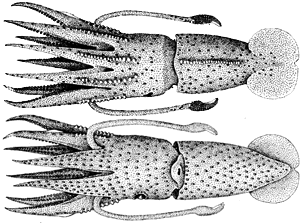Histioteuthis miranda
Richard E. Young and Michael VecchioneIntroduction
H. miranda is often the most common histioteuthid captured within its habitat. This species is believed to be associated with shallow ocean-floor topography. It is broadly distributed in southern waters but Voss et al., 1998, found no indication of population differentiation throughout the range of this species.
Characteristics
- Tubercles
- Arms I with 14-19 tubercules; arms II with 11-16 tubercules and arms III with 7-13.
- Length of tubercule-rows 19-39% of arm lengths.
- Photophores
- Arms IV with 5 longitudinal series on arm base.
Comments
More details of the description can be found here.Species of the miranda-group are distinguished by the following characteristics:
- Tubercles
- Present on dorsal midline of mantle and aboral surface of arms I-III.
- Photophores
- In 5-6 series on arm IV base.
- Compound photophores of uniform, medium size on anterior 3/4 of ventral mantle.
H. miranda is most easily separated from the other member of the miranda-group, H. oceani, by (1) the lesser number of photophores on the base of arms IV (5 vs 6), (2) the lesser number of tubercules in on each arm, (3) the lesser length of the tubercule rows on the arms, and the divided buccal connectives to arms II (attach to arms I and II).
The above data are taken from Voss, et al. (1998).
Distribution
Geographical distribution
Type locality: South by southeast of Gabo Island, Victoria, Australia (ca. 38°S,150°E). H. miranda is found off southwest Africa eastward to the Australia-New Zealand area. It occurs near continental slopes, islands and submarine rises (Voss, et al., 1998).
References
Voss, N. A. 1969. A monograph of the Cephalopoda of the North Atlantic: The family Histioteuthidae. Bull. Mar. Sci., 19: 713-867.
Voss, N.A., K. N. Nesis, P. G. Rodhouse. 1998. The cephalopod family Histioteuthidae (Oegopsida): Systematics, biology, and biogeography. Smithson. Contr. Zool., 586(2): 293-372.
Title Illustrations

| Scientific Name | Histioteuthis miranda, Histioteuthis miranda (2) |
|---|---|
| Location | 37° 54''S, 178° 56''E, 37° 54''S, 178° 56''E (2) |
| Reference | from Voss, N. A. 1969. A monograph of the Cephalopoda of the North Atlantic: The family Histioteuthidae. Bull. Mar. Sci. 19:713-867. printed with permission |
| Sex | f, f (2) |
| View | dorsal, ventral (2) |
| Size | 182 mm ML, 182 mm ML (2) |
| Type | neotype, neotype (2) |
| Copyright | © 1969 Bulletin of Marine Science |
About This Page
Drawings from Voss (1969) printed with the Permission of the Bulletin of Marine Science.

University of Hawaii, Honolulu, HI, USA

National Museum of Natural History, Washington, D. C. , USA
Page copyright © 2013 and
 Page: Tree of Life
Histioteuthis miranda .
Authored by
Richard E. Young and Michael Vecchione.
The TEXT of this page is licensed under the
Creative Commons Attribution-NonCommercial License - Version 3.0. Note that images and other media
featured on this page are each governed by their own license, and they may or may not be available
for reuse. Click on an image or a media link to access the media data window, which provides the
relevant licensing information. For the general terms and conditions of ToL material reuse and
redistribution, please see the Tree of Life Copyright
Policies.
Page: Tree of Life
Histioteuthis miranda .
Authored by
Richard E. Young and Michael Vecchione.
The TEXT of this page is licensed under the
Creative Commons Attribution-NonCommercial License - Version 3.0. Note that images and other media
featured on this page are each governed by their own license, and they may or may not be available
for reuse. Click on an image or a media link to access the media data window, which provides the
relevant licensing information. For the general terms and conditions of ToL material reuse and
redistribution, please see the Tree of Life Copyright
Policies.
Citing this page:
Young, Richard E. and Michael Vecchione. 2000. Histioteuthis miranda . Version 01 January 2000 (under construction). http://tolweb.org/Histioteuthis_miranda/19806/2000.01.01 in The Tree of Life Web Project, http://tolweb.org/










 Go to quick links
Go to quick search
Go to navigation for this section of the ToL site
Go to detailed links for the ToL site
Go to quick links
Go to quick search
Go to navigation for this section of the ToL site
Go to detailed links for the ToL site